広重の世界に浸ってまいりました(愛知県名古屋市千種区姫池通 骨董買取 古美術風光舎)
2024.07.10
皆さまこんにちは。スタッフHでございます。
また通りすがりにいつもの美術館に立ち寄ってまいりました。この酷暑の中、駅に直結していて訪れやすいというのもあるのですが、こちらの美術館のポスターはいつも迫力満点で、つい吸い込まれて入館してしまいます。今回のテーマは江戸の浮世絵師、歌川広重の「広重-摺りの極み―」です。浮世絵というものを肉眼で見たことがなかったのでこの機会を逃す手はありません。
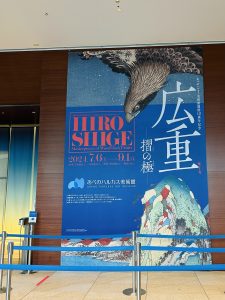
とはいえ思い付きでしたので、あまり時間に余裕がなく、ほんのちょっと覗くつもりが中に入ると340点近くの作品が展示されており、とてもちょっとでは済まない様子…。同時代に活躍した葛飾北斎展が数年おきにどこかしらで開催されているのに対し、広重の大規模かつ総合的な展覧会はあまり開催されていないらしく、希少な初摺り作品をはじめ初期から晩年までの作品が並べられ広重の魅力を堪能できます。
展覧会後期には違う作品も展示されるようですので、機会があれば今度こそゆっくりと鑑賞したいところです。
実は先日阿部サダヲ主演の「広重ぶるう」というドラマを観たところで、どうしても広重と聞くと阿部サダヲが脳裏にちらついていたのですが、三代歌川豊国が描いた広重の姿絵が最初に紹介されていたので払拭することができました。
ドラマのタイトルにもあるように、広重の青は「広重ブルー」と呼ばれ、透明感のある鮮やかな青を指します。実はこの青はドイツのベルリンの染料業者が原料の調合を間違えて偶然発見したとされる科学的な合成顔料で、日本には1747年に輸入されたとされています。発見された地名をとって名づけられた「ベルリン藍」はやがて「ベロ藍」と呼ばれるようになりました。
この見たこともない鮮明な青に江戸時代の人々は驚き、このベロ藍で摺られた広重や北斎の浮世絵が大人気を博しました。
新1000円札のデザインにもなっている北斎の「神奈川沖浪裏(かながわおきなみうら)」もこの鮮やかな青の濃淡があってこそ、あの波の迫力が生まれたと言われています。
それまで浮世絵の青は色あせが激しい植物由来のものが多く、明るい青を出す鉱物由来の顔料は高価で、庶民向けの浮世絵には使えなかったとのこと。
「ジャパンブルー」と呼ばれた広重や北斎の浮世絵の青は世界を驚かせましたが、その青色はベルリン生まれだったのですね。
展覧会を巡っていますと広重の青の多彩に魅了されます。白々と明けていく朝の情景から、夕闇の深さまで青の濃淡で繊細に描かれています。
また着物の帯や提灯などに指し色のように入る赤や雪の白なども印象的でした。素人目からみても構図が面白く、たくさんの作品を観ていてもあきません。少し駆け足でしたが、どっぶりと江戸の風景に浸ることができました。
広重の絵の特徴でもあるいきいきとした人物画を楽しむためには老眼鏡(リーディンググラス?)が必須かと思われます。とにかく細かいのです。黙り込んでいるような人物や、後ろ姿だけの人物にもストーリー性を感じ想像力が掻き立てられます。
広重といえば「東海道五十三次」くらいしか思い浮かびませんでしたが、「木曽街道六十九次」も描いております。こちらは写真撮影がOKだったものです。
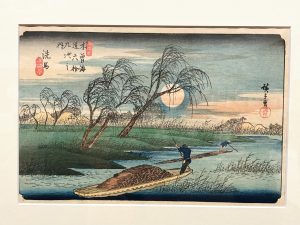
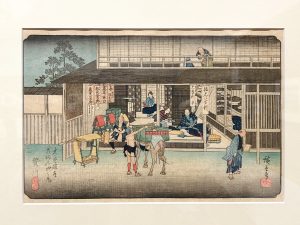
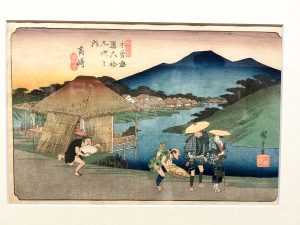
私の写真では色の美しさは伝わりにくいと思いますが。
また花鳥画、美人画、戯画、役者絵、絵封筒など多くの作品を残しています。絵ハガキを何枚か購入しました。
こちらの美人画は動きがあり、夕闇に吹き抜ける風を感じませんか。
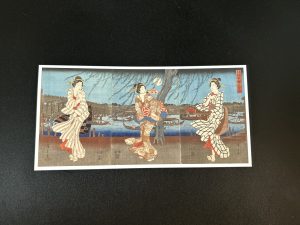
そして「月に秋草」名づけられたこちらの団扇絵(うちわえ)は世界でこの1枚しか現存しないそうです。すすきや女郎花などの草花が満月をバックに描かれとても涼やかです。
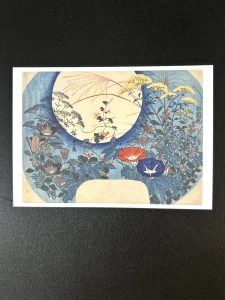
こんな団扇であおげたら…と外の酷暑を想像しながら、あまりゆっくり鑑賞できなかったことを悔しく思いながら展覧会をあとにしました。
それでは、また次の機会に。
Hello everyone. This is Staff H.
I dropped by the usual art museum again on my way by. It is easy to visit the museum because it is directly connected to the station in this extremely hot summer, but the posters of this museum are always full of power, and I am always drawn into the museum. The theme of this year’s exhibition was Hiroshige Utagawa Hiroshige, an ukiyoe artist of the Edo period, and his “Hiroshige: The Ultimate in Printmaking. I had never seen Ukiyo-e with my own eyes, so there was no way I could miss this opportunity.
However, since it was an impromptu visit, I didn’t have much time to spare, and what was supposed to be a quick peek turned out to be more than a quick one, with nearly 340 works on display. While exhibitions of Katsushika Hokusai, who was active in the same period, are held somewhere every few years, it seems that large-scale and comprehensive exhibitions of Hiroshige’s works are rarely held, so visitors can enjoy the charm of Hiroshige’s works from his early years to his later years, including rare first prints.
It seems that different works will be exhibited in the latter half of the exhibition, so if you have a chance, I would like to take the time to view them again.
I had just watched the TV drama “Hiroshige Buruu” starring Sadawo Abe the other day, and when I heard the name Hiroshige, I couldn’t help but think of Sadawo Abe, but I was able to get rid of it when I saw the first picture of Hiroshige drawn by Toyokuni Utagawa III.
As the title of the drama suggests, Hiroshige’s blue is called “Hiroshige blue,” which refers to a clear and vivid blue. In fact, this blue is a scientifically synthesized pigment that was accidentally discovered by a dyer in Berlin, Germany, who made a mistake in mixing raw materials, and was imported to Japan in 1747. Berlin indigo, named after the place where it was discovered, eventually became known as “Vero indigo.
The people of the Edo period were amazed at this unprecedentedly vivid blue, and ukiyoe paintings by Hiroshige and Hokusai, which were printed with this Bero-Ai, became very popular.
Hokusai’s “Kanagawa Okinamiura,” which is also the design for the new 1,000-yen bill, is said to have been created with this vivid shade of blue to create the power of the waves.
Until then, most of the blues used in Ukiyo-e were derived from plants, which fade rapidly, and mineral pigments, which produce a bright blue color, were too expensive to use in Ukiyo-e for the general public.
The blue of Hiroshige and Hokusai’s Ukiyo-e, called “Japan blue,” astonished the world, but that blue was born in Berlin.
When I visited the exhibition, I was fascinated by the variety of Hiroshige’s blue. From the morning scene in the light of dawn to the depths of dusk, the shades of blue are delicately depicted.
The red and white of the snow on the kimono obi and lanterns were also impressive. From an amateur’s point of view, the compositions were interesting, and one never got tired of looking at the many works. Although the tour was a bit rushed, I was able to fully immerse myself in the scenery of Edo.
Reading glasses (or reading glasses?) are required to enjoy Hiroshige’s lively portraits, which are characteristic of his paintings. reading glasses are necessary to enjoy Hiroshige’s lively portraits, which are characteristic of his paintings. The paintings are very detailed. Even figures who seem to be silent or only in the back are telling a story, which stirs the viewer’s imagination.
Speaking of Hiroshige, only “53 Stages of the Tokaido” came to mind, but he also painted “69 Stages of the Kiso Kaido. This one I was allowed to photograph.
I think it is difficult to convey the beauty of the colors in my photographs.
He also left many works such as flower-and-bird paintings, beautiful women paintings, caricatures, pictures of actors, and picture envelopes. I purchased several postcards.
This picture of a beautiful woman has movement, and don’t you feel the wind blowing through the darkness of the evening?
This fan painting, named “Autumn Flowers on the Moon,” is said to be the only one of its kind in the world. It is very cool with flowers and grasses such as Japanese pampas grass and gynostemma against the full moon.
I left the exhibition feeling regretful that I could not spend more time viewing the works, imagining the extreme heat outside.
See you next time.
*******************
ご実家の整理やお片付けなどをされている方のご相談などが多くございます。
お片付けなどくれぐれもご無理のないようになさってくださいませ。
風光舎では古美術品や骨董品の他にも絵画や宝石、趣味のお品など様々なジャンルのものを買受しております。
お片付けをされていて、こういうものでもいいのかしらと迷われているものでも、どうぞお気軽にご相談下さいませ。
また風光舎は、出張買取も強化しております。ご近所はもちろん、愛知県内、岐阜県、三重県その他の県へも出張いたします。
まずは、お電話お待ちしております。
愛知県名古屋市千種区姫池通
骨董 買取【古美術 風光舎 名古屋店】
TEL052(734)8444
10:00-18:00 OPEN

